In recent years, AI chatbots have been all the buzz in the tech and business world. AI chatbot examples from companies, big and small, show success in customer interactions. As conversational AI continues to develop, consumers increasingly engage with chatbots. Statistics show definite growth in the use of bots, which is only expected to grow.

AI-powered chatbots mimic written conversations or recorded speech to interpret customer inquiries. If done correctly, this service helps businesses connect with their customers. However, simply adding a chatbot to a website can do more damage than good. Inefficient and inadequate chatbots can frustrate customers.
In addition to enhancing customer service, chatbots are also effective in reducing costs and boosting revenue in contact centers. Their role in automating simple customer requests, such as changing passwords, requesting balances, and scheduling appointments, is a prime example of streamlined it management services. This automation eliminates the need for excessive human involvement in routine tasks, leading to significant cost savings and more efficient IT operations for businesses.
According to Chatbots Magazine, companies can reduce customer service costs by up to 30% by implementing conversational chatbots.
Furthermore, chatbots prove to be a valuable investment for contact centers as they upgrade from inefficient Interactive Voice Response (IVR) technology to AI-powered solutions. This transition not only streamlines customer interactions but also results in substantial cost reductions. The ability to handle basic inquiries and perform routine tasks enables contact centers to allocate their human resources more efficiently, focusing on complex and high-value customer interactions.
The examples in this article will demonstrate the power of well-implemented chatbots in various industries. By providing effective customer service and addressing customer needs promptly, chatbots contribute to customer satisfaction and loyalty. This, in turn, can lead to increased revenue as satisfied customers are more likely to engage in repeat business and recommend the company to others. In summary, chatbots play a crucial role in reducing customer service costs and boosting revenue in contact centers. Through automation and improved efficiency, businesses can achieve significant cost savings while simultaneously enhancing customer experiences. With the right implementation and a focus on meeting customer needs, chatbots prove to be a valuable asset for businesses across industries.
Here are some AI chatbots examples that show the power of well-implemented chatbots. They demonstrate various use cases of chatbots throughout various industries. And they illustrate the power of effective customer service through the help of AI.
Check out our new ChatGPT customer-service features that can help agents and customers connect more efficiently.
AI Chatbot Examples
1. Amazon Lex: Virtual Assistant AI Chatbot
We’ve all heard of Amazon Alexa – a smart home virtual assistant. It can make grocery lists and sing you a song if you ask nicely (and maybe even if you don’t.)
But Alexa has a business-application cousin, Lex. According to the chatbot overview, “Amazon Lex is a fully managed artificial intelligence (AI) service with advanced natural language models to design, build, test, and deploy conversational interfaces in applications.”

“Amazon Lex helps you build, test, and deploy chatbots and virtual assistants on contact center services (such as Amazon Connect), websites, and messaging channels (such as Facebook Messenger). The automated chatbot designer expands the usability of Amazon Lex to the design phase. It uses machine learning (ML) to provide an initial bot design that you can then refine and launch conversational experiences faster.” (Amazon Web Services)
Thanks to the ability to automate a broad range of tasks, providers like ScalaHosting build AWS VPS hosting services. Companies love them because they allow them to develop their business in a reliable environment that can be scaled according to their needs.
2. Synchrony Bank Assistant: Simple Tasks Chatbot
The rules of cybersecurity change constantly. Perhaps one of the most common (and most annoying) problems many web users encounter is log-ins. Customers often find themselves unable to log in to their accounts.
Synchrony Bank serves as a great example of chatbots-assist. After three failed log-in attempts, Sydney the chatbot enters the scene. In only a few steps, she helps the customer recover their login username and reset the password. Thai eliminates the need to contact customer service. Once the recovery process is finished, the customer is able to log into the account effortlessly.
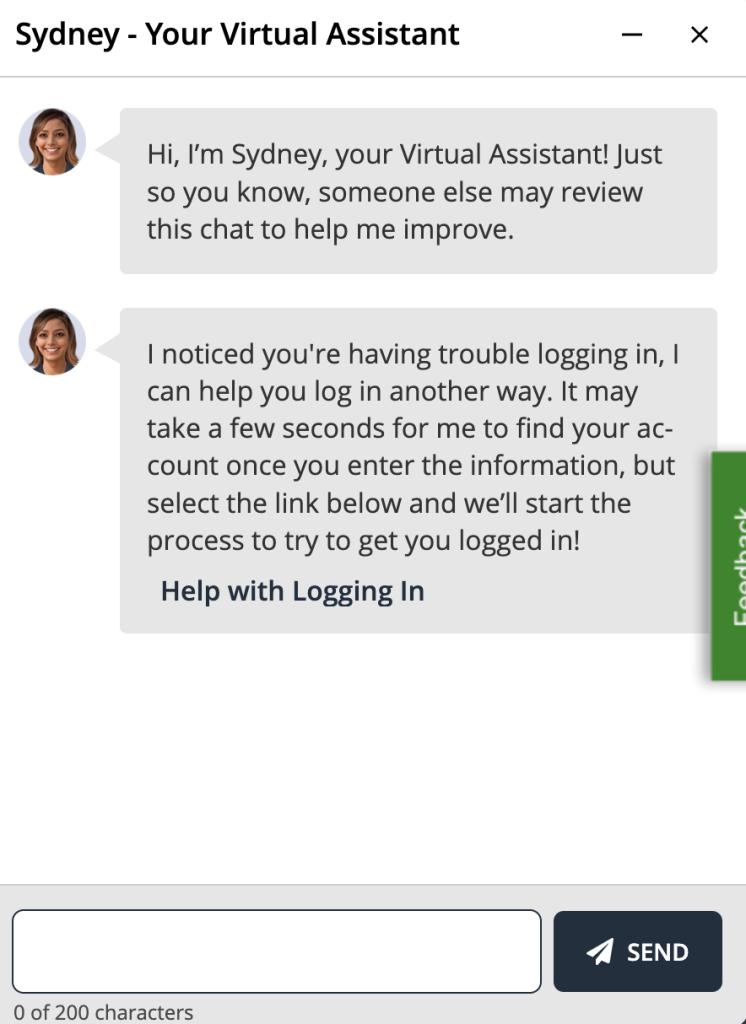
3. Dominos: Facebook Ordering Messenger
Domino’s Facebook Messenger chatbot is a great example of a food industry use case. The success of this menu-based chatbot lies in its simplicity and accessibility. The bot is available on the company’s Facebook page. And so it allows customers to order or connect to the company’s customer service anywhere. The bot presents visitors with few options. The bot also has the ability to recall the customer’s previous orders. That allows for simple reorders and makes the customer experience all the better.
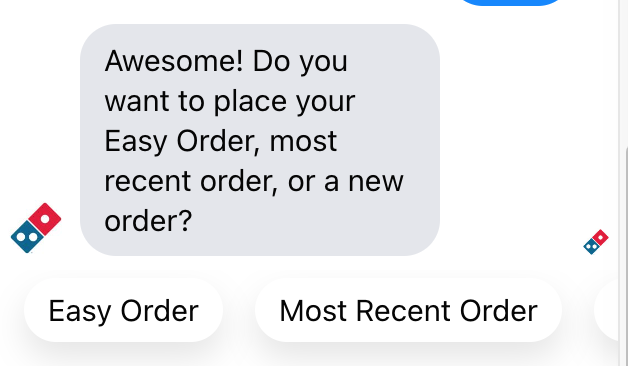
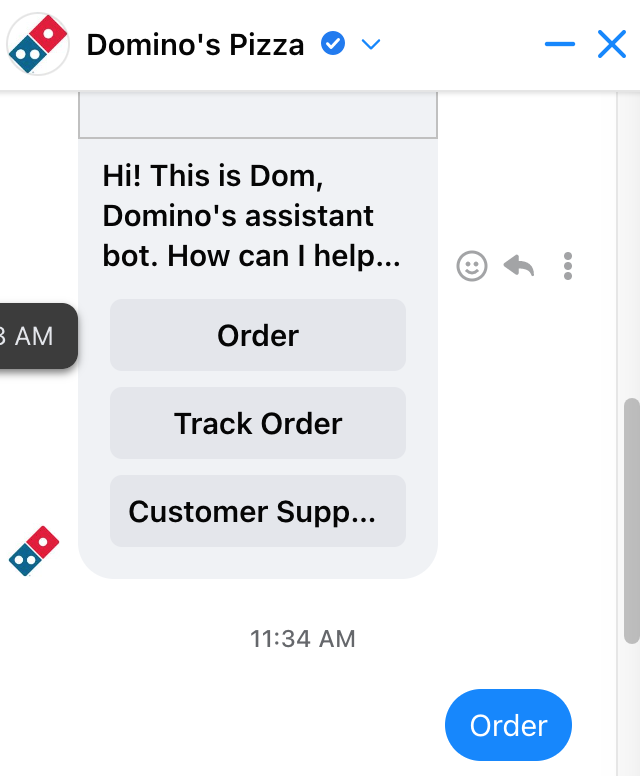
4. H&M Chatbot: Fashion Help
The fashion and retail industry can also benefit from the use of AI-powered technology.
H&M bot is a good example of this practice working well. Based on visitors’ replies, the bot offers a variety of resources tailored to their interests. By leveraging the information provided by customers, the chatbot provides detailed instructions for the next steps of their buyer’s journey. Whether it’s suggesting outfit possibilities or Microsoft AI-900 Practice Exam Dumps to specific areas of the online store that align with their purchase desires, H&M’s chatbot ensures a personalized and seamless shopping experience. Shoppers can explore different options and receive outfit recommendations based on their preferences. If a suggested outfit is not to their liking, the chatbot quickly selects a different option, ensuring customer satisfaction. This implementation has proven successful for H&M, with consistent sales growth and the expansion of new online markets. The chatbot’s ability to recommend products based on customer interests has undoubtedly contributed to these positive results, making it a valuable tool for enhancing the overall shopping experience at H&M.
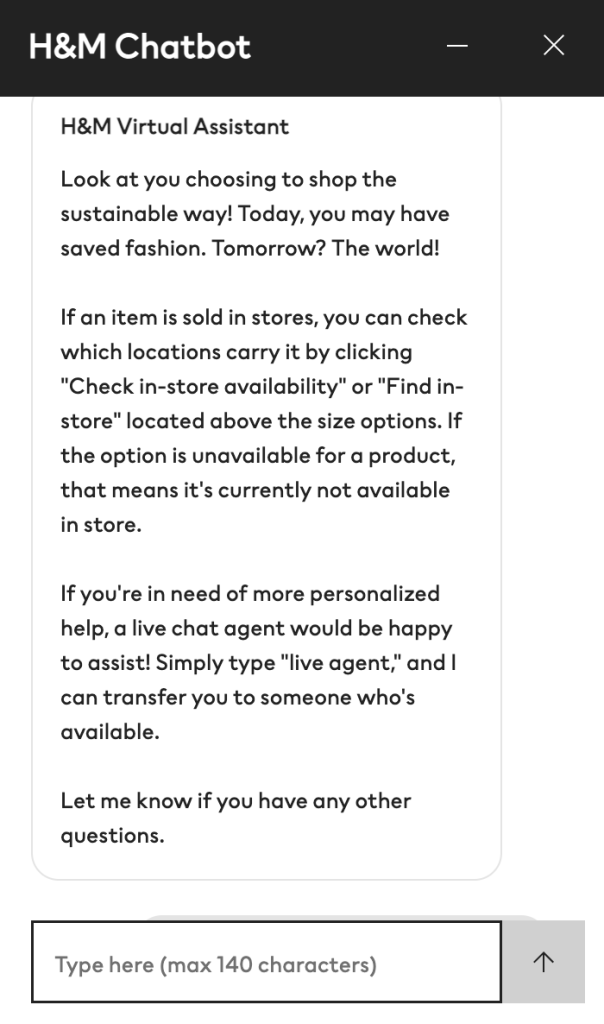
5. Mya StepStone: Job Search AI Chatbot
BLOCKQUOTE: “Today, online job search still relies on job seekers typing in job titles and locations. As a result, many people do not find the right job. In the future, conversational AI will help us to have meaningful interactions with our users and to find out what really matters to them”, said StepStone CEO Dr. Sebastian Dettmers. “Our goal is to fundamentally change how job seekers discover their full range of opportunities.” (StepStone)
Another AI chatbot example application is Mya, recently acquired by StepStone. StepStone is a job recruiting agency. According to the company’s press release, “based on machine learning, conversational AI will enable job seekers to find matching job opportunities even without actively searching for them. The technology draws conclusions from talking to the candidate and then suggests suitable jobs via text message, WhatsApp, or onsite chat.”
Mya, an AI-powered assistant, plays a critical role in L’Oréal’s recruiting process by utilizing various communication channels such as SMS, Facebook, Skype, email, and chat to engage with multiple candidates simultaneously. Through these channels, Mya performs a range of tasks that aid in the recruitment process.
Firstly, Mya acts as an initial point of contact by asking pre-screening questions and providing responses to frequently asked questions (FAQs) from candidates. This ensures that candidates are provided with relevant information promptly and efficiently.
Additionally, Mya keeps candidates updated on the progress of their applications, providing them with real-time alerts. It also offers valuable tips and guidance throughout the application process, enhancing candidates’ understanding and increasing their chances of success.
Furthermore, Mya administers assessments and challenges to candidates, enabling the evaluation of their skills and suitability for specific roles. This aids recruiters and managers in ranking candidates based on factors like experience, recent activity, engagement, and various metrics.
The implementation of Mya has significantly improved candidate satisfaction at L’Oréal. Candidates appreciate the efficient and personalized engagement, resulting in an engagement rate of 92% across the candidates. Moreover, the high-quality interaction with Mya has contributed to an impressive near 100% level of satisfaction.
Overall, Mya functions as a multipurpose assistant in L’Oréal’s AI recruiting process by utilizing various communication channels, delivering valuable information and updates, administering assessments, and ensuring a seamless and satisfactory experience for candidates.
In the telecom industry, one of the key findings from using Mya as a chatbot example is the significant increase in candidate satisfaction. By leveraging Mya’s capabilities, telecom companies have noticed a surge in the number of applications received, with some even surpassing over 1 million applications per year. Mya’s efficient engagement with candidates has played a crucial role in achieving a near 100% satisfaction rate. This positive experience has been further reinforced by the great feedback received from applicants, who have appreciated how easy and personal the interaction felt. These insights highlight the value of integrating chatbot technology, like Mya, in the telecom industry, as it leads to improved candidate satisfaction and a more streamlined recruitment process.
6. Home Boutique: Real Estate AI Chatbot
With remote work on the rise, domestic migration out of urban cores spiked. Tech innovations help homebuyers shop from the comfort of their living rooms. Virtual property tours come in handy.
AI Chatbots can help real estate companies by facilitating virtual tours. Tasking a chatbot with this task frees up agents to attend to other matters. It allows customers to take their time with the tour and explore the property in detail before visiting it in person.
Using chatbots in the real estate industry include the importance of personalization and collecting valuable lead information. By tailoring the bot to respond to personalized questions, real estate businesses can enhance the accuracy and relevance of the results provided to customers. Additionally, training the chatbot to understand customer needs and offering video or text-based answers can greatly improve the overall customer experience. These key learnings help real estate businesses effectively utilize chatbots to better meet customer requirements and provide a more engaging and informative journey.
A good AI Chatbot offers a 360-degree view of the property. It allows different viewing options and can help schedule an in-person visit for the homebuyer as well.

Structurely’s chatbot, Asia Holmes, is another exceptional example of an AI chatbot that effectively engages and qualifies online leads in the real estate industry. By employing a personalized approach, Holmes asks a series of intelligent questions to determine each user’s specific property preferences. This helps to create a more tailored and effective conversation between the chatbot and potential customers.
One of the key features of Holmes is its ability to provide real-time assistance by promptly answering customer queries. By instantly responding to inquiries, Holmes ensures that leads are engaged and receive the information they need in a timely manner. This feature helps to establish a positive and efficient customer experience.
Moreover, Holmes goes beyond simple engagement by offering personalized updates to users based on their preferences. Interested customers can request to receive home updates about the ideal buying times in specific areas. By doing this, the chatbot keeps potential buyers informed about market trends and ensures they are aware of the best opportunities to make a purchase.
In addition to engaging and providing updates, Holmes also excels at qualifying leads. By asking insightful questions, it collects essential information about users’ property preferences and requirements. This data allows the chatbot to identify and recommend ideal listings based on specific features that customers are looking for. For instance, if a customer is interested in properties with a specific kitchen design, Holmes can leverage this information to offer related listings that meet their criteria.
Overall, Structurely’s chatbot, Asia Holmes, effectively engages and qualifies online leads in the real estate industry by personalizing the experience, promptly addressing queries, providing tailored updates, and delivering relevant property suggestions based on users’ preferences.
7. Siri, Alexa, and Google Assistant: Conversational AI Chatbots
Alexa, Siri, and Google Assistant are all examples of conversational AI. More human-like in their conversation programming, these chatbots generate more natural responses. In other words, interactions with these chatbots are the closest to human-like conversations.
Machine learning technology gives these chatbots accuracy and natural language capabilities. When Siri or Alexa makes a mistake in a conversation with a human, it learns from it. Computer systems analyze data and patterns to guide the assistants’ decision-making. Machines learn on their own without human assistance. That allows them to develop greater capabilities.
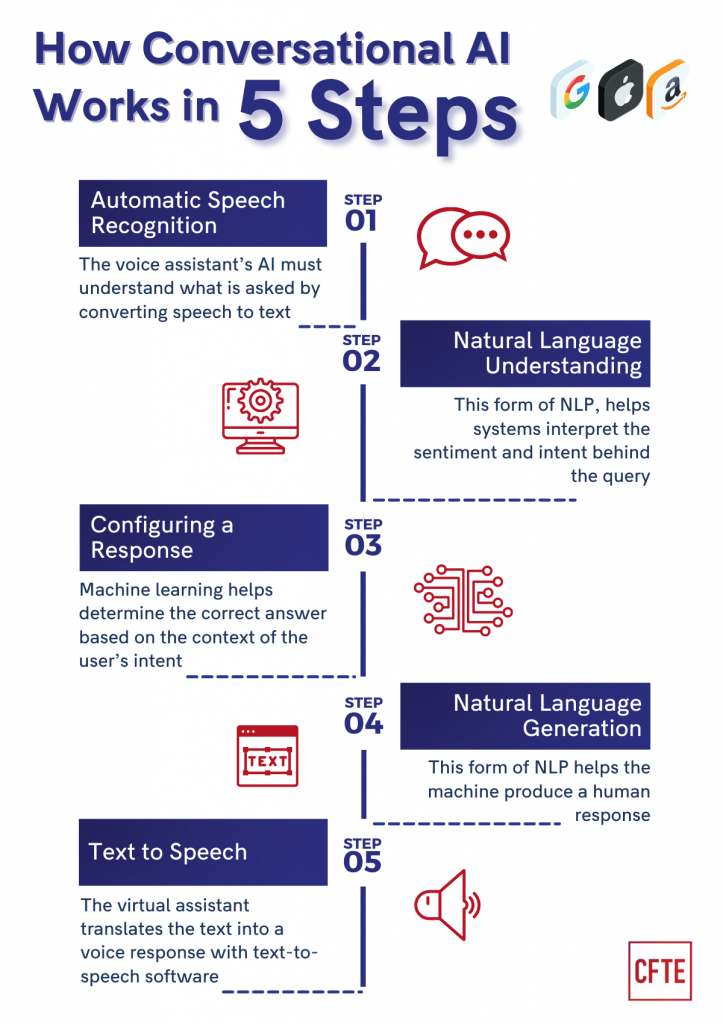
8. JetBlue: Mobile Option and Helpful Directions
In whatever area a customer requires assistance, JetBlue’s chatbot is there to help. The contact page directs visitors to a page that gives them choices on how to connect – via webchat or mobile. Then, it asks a series of questions to direct the customers to the right places. Plenty of options within the chat widget ensure that the customer gets to the right place.
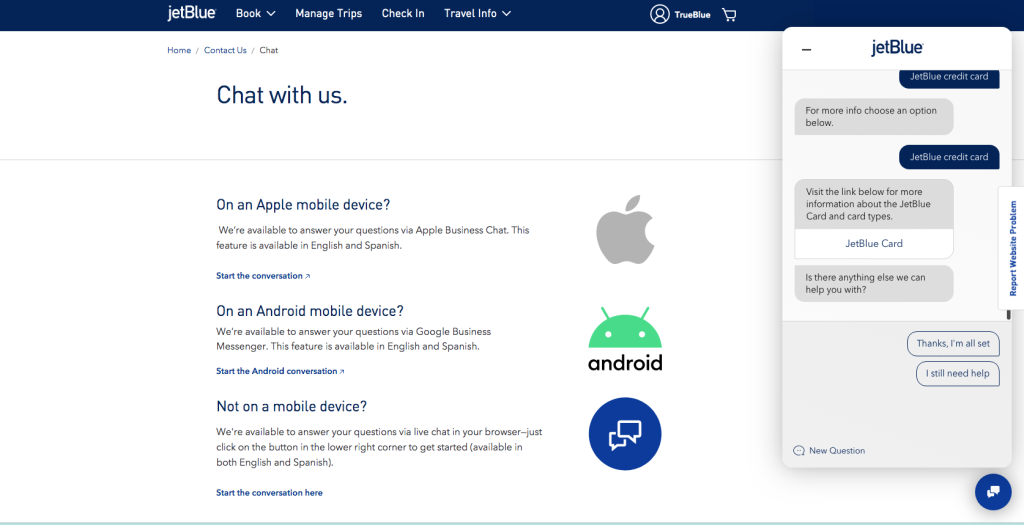
9. LiveHelpNow: DIY AI Chatbot
Suitable for any industry, our chatbots serve as helpful customer service and marketing assistants. Whatever the need for the chatbot is, the Chatbot User Interface will help admins set it up just the way they want it. The AI Chatbot can support SMS or Desktop communications with customers.
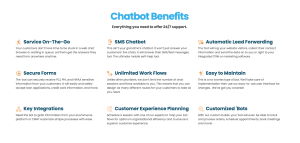
Our customized chatbots answer order questions, set appointments, conduct surveys, calculate answers, collect confidential information, and more. Of course, there may be issues that you prefer your staff to handle. Our bots can delegate inquiries to specific departments or agents based on specific criteria.
Customer service enrichment with AI chatbot
Chatbots have emerged as a powerful tool for enhancing customer conversations without the need for traditional form fill-ups. By combining a well-executed lead generation strategy with chatbot technology, businesses have the opportunity to generate a significant number of leads.Similarly, AI-powered solutions like an AI-powered essay generator for students can help students generate essays efficiently, reducing the time spent on writing while ensuring quality content. This mirrors the efficiency gained in customer service through chatbots, streamlining a typically time-consuming process.
In the past, filling up forms was the conventional method of generating sales leads. However, the conversion rate through lead generation forms typically ranges from 2.5% to 5%. Recognizing the limitations of this approach, businesses have turned to chatbots to streamline their lead generation process and improve customer engagement.
One key advantage of using chatbots for lead generation is that they are highly adaptive to the preferences of website visitors. Many customers may not prefer filling out forms, finding them tedious or time-consuming. By implementing a sales chatbot, businesses can create a more interactive and user-friendly experience. These chatbots are programmed to ask relevant questions, allowing customers to conveniently provide their contact information. This approach proves to be more engaging and increases the likelihood of obtaining valuable leads.
An excellent example of this is Vainu, a data analytics service that developed an innovative chatbot called VainuBot. This chatbot engages with customers in dynamic and personalized conversations, employing a series of carefully tailored questions to qualify and engage website visitors. By presenting visitors with selectable options that are most relevant to their needs, the chatbot enables them to make quick and informed choices. At the conclusion of the conversation, the chatbot politely requests the visitor’s email address, providing an opportunity to book a demo or send a tailored report, ultimately furthering the lead generation process.
By leveraging chatbots in this manner, businesses can enrich customer conversations by capturing leads in a more efficient and customer-centric way. For example, companies can manage rental transactions with tools like the rental cash invoice receipt template to streamline invoicing alongside their customer service efforts. These interactive chatbots not only offer visitors a more engaging experience but also allow businesses to gather valuable contact information while ensuring a seamless and user-friendly process.
Tips for Creating a Successful Chatbot
The process of creating a functional chatbot conversation logic that fits customers’ needs and flows naturally might take some practice. Creating a few different flows, testing them, and seeing what works best is a great way to start.
We also recommend checking out the following resources that can help with the task:
Conversation Design Workflow: How to design your chatbot in 10 (basic) steps
10 Tips for Creating Engaging Chatbot Design People Will Use
Best Practices for AI Chatbots
- Use high-quality tools to facilitate human-like natural language conversations
- Determine the intent of the chatbot communications
- Use clear logic with no room for vagueness or mistakes
- Present clear benefits to the customer for using the chatbot to increase customer engagement
- Implement features that support the personalization of customer experience.
- Collect customer feedback and use it to improve interactions
Conclusion
AI in customer service continues to develop. Chatbots can enhance customer experience. They can promote products in the eCommerce space. They can advance marketing efforts in many spheres. And they have many other applications. Is there room and need for a chatbot in your business? Think about the AI Chatbot examples above. Find a successful implementation strategy. Then, this smart technology can help your business thrive.
Read more about LiveHelpNow AI-powered tools.



